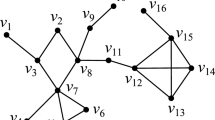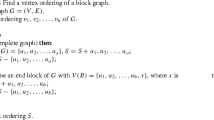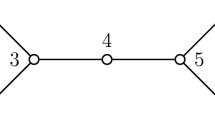Abstract
The concept of power domination emerged from the problem of monitoring electrical systems. Given a graph G and a set \(S \subseteq V(G)\), a set M of monitored vertices is built as follows: at first, M contains only the vertices of S and their direct neighbors, and then each time a vertex in M has exactly one neighbor not in M, this neighbor is added to M. The power domination number of a graph G is the minimum size of a set S such that this process ends up with the set M containing every vertex of G. We show that the power domination number of a triangular grid \(H_k\) with hexagonal-shaped border of length \(k-1\) is \(\left\lceil \dfrac{k}{3} \right\rceil \), and the one of a triangular grid \(T_k\) with triangular-shaped border of length \(k-1\) is \(\left\lceil \dfrac{k}{4} \right\rceil \).















Similar content being viewed by others
Notes
We here consider that if \(j=x\), then \(j+1=y\) and \(j+2=z\), and additions are done modulo 3.
References
Aazami A (2010) Domination in graphs with bounded propagation: algorithms, formulations and hardness results. J Combin Optim 19(4):429–456
Baldwin TL, Mili L, Boisen MB, Adapa R (1993) Power system observability with minimal phasor measurement placement. IEEE Trans Power Syst 8(2):707–715
Barrera R, Ferrero D (2011) Power domination in cylinders, tori, and generalized Petersen graphs. Networks 58(1):43–49
Benson KF, Ferrero D, Flagg M, Furst V, Hogben L, Vasilevska V, Wissman B (2018) Zero forcing and power domination for graph products. Aust J Combin 70(2):221
Bozeman C, Brimkov B, Erickson C, Ferrero D, Flagg M, Hogben L (2019) Restricted power domination and zero forcing problems. J Combin Optim 37(3):935–956
Brimkov B, Mikesell D, Smith L (2019) Connected power domination in graphs. J Combin Optim 38(1):292–315
Dorbec P, Klavžar S (2014) Generalized power domination: propagation radius and Sierpiński graphs. Acta Appl Math 134(1):75–86
Dorbec P, Mollard M, Klavžar S, Špacapan S (2008) Power domination in product graphs. SIAM J Discrete Math 22(2):554–567
Dorbec P, Varghese S, Vijayakumar A (2016) Heredity for generalized power domination. Discrete Math Theor Comput Sci 18(3). https://dmtcs.episciences.org/1422
Dorfling M, Henning MA (2006) A note on power domination in grid graphs. Discrete Appl Math 154(6):1023–1027
Ferrero D, Varghese S, Vijayakumar A (2011) Power domination in honeycomb networks. J Discrete Math Sci Cryptogr 14(6):521–529
Gonçalves D, Pinlou A, Rao M, Thomassé S (2011) The domination number of grids. SIAM J Discrete Math 25(3):1443–1453
Guo J, Niedermeier R, Raible D (2008) Improved algorithms and complexity results for power domination in graphs. Algorithmica 52(2):177–202
Haynes TW, Hedetniemi SM, Hedetniemi ST, Henning MA (2002) Domination in graphs applied to electric power networks. SIAM J Discrete Math 15(4):519–529
Koh KM, Soh KW (2016) Power domination of the cartesian product of graphs. AKCE Int J Graphs Combin 13(1):22–30
Liao CS (2016) Power domination with bounded time constraints. J Combin Optim 31(2):725–742
Liao CS, Lee DT (2005) Power domination problem in graphs. In: International computing and combinatorics conference. Springer, Berlin, pp 818–828
Mili L, Baldwin T, Adapa R (1990) Phasor measurement placement for voltage stability analysis of power systems. In: Proceedings of the 29th IEEE conference on decision and control, pp 3033–3038
Xu G, Kang L, Shan E, Zhao M (2006) Power domination in block graphs. Theor Comput Sci 359(1–3):299–305
Zhao M, Kang L, Chang GJ (2006) Power domination in graphs. Discrete Math 306(15):1812–1816
Author information
Authors and Affiliations
Corresponding author
Additional information
Publisher's Note
Springer Nature remains neutral with regard to jurisdictional claims in published maps and institutional affiliations.
Research supported in part by NSERC and the GdR-iM of CNRS.
Rights and permissions
About this article
Cite this article
Bose, P., Gledel, V., Pennarun, C. et al. Power domination on triangular grids with triangular and hexagonal shape. J Comb Optim 40, 482–500 (2020). https://doi.org/10.1007/s10878-020-00587-z
Published:
Issue Date:
DOI: https://doi.org/10.1007/s10878-020-00587-z




